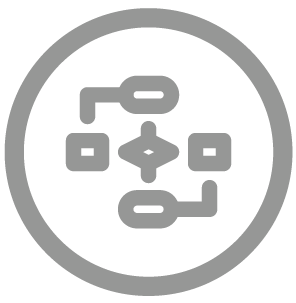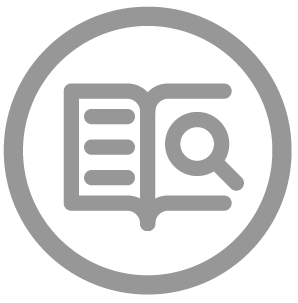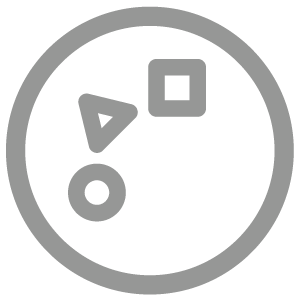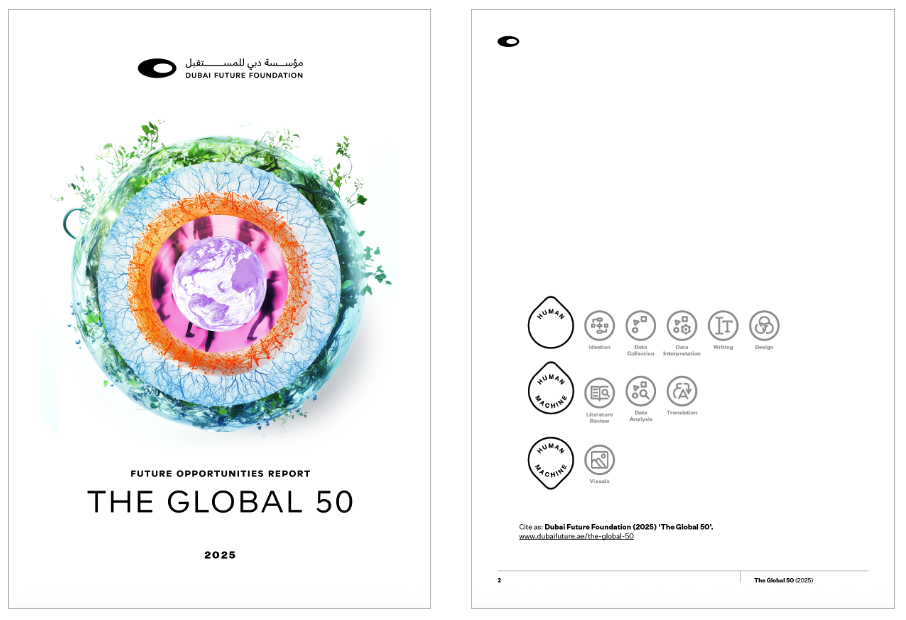Icons for human - machine collaboration (HMC):
Visual Standards for Research and Publications
Beta Version
Overview
‘What if we had a Turing declaration for human intelligence?’, this was the question for the future in Opportunity 41 in the 2024 edition of The Global 50 report for the post-Turing era, where machine language and intelligence are indistinguishable from human language and intelligence: To follow up on this opportunity, while acknowledging the nuanced evolving nature of human–machine collaboration, the Dubai Future Foundation (DFF) is introducing a classification system that supports a visual representation of the evolving human-machine collaboration in research, design and publications.
Effective from the date of the white paper, every DFF research report will display respective icons for human-machine collaboration, demonstrating our commitment to transparency and establishing a new standard for ethical research practices.
Common Research, Design and Publications Functions
As a foundation for the development of the classification system, we considered various processes that may involve machines:
- Conceptualisation: The process of generating ideas and combining concepts to create new insights or solutions. It includes brainstorming, problem-framing, idea development, and the design of approaches and research methodologies.
- Data collection: The application of varied approaches to collect information through primary or secondary research.
- Data analysis: The application of varied methods, both qualitative and quantitative, to analyse information collected through primary or secondary research.
- Data interpretation: The application of critical analysis and reflection to uncover thematic findings and conclusions from collected and analysed data.
- Writing: The use of written language to express opinions, present findings and provide critical analysis.
- Translation: The process of converting text from an original, authoritative and operative version into another language while maintaining its meaning and intent.
- Visuals: Components of a report, video or other content used to convey information visually. These may include images, charts, graphs, visualisations, motion graphics and other representations.
- Design: The process and output of organising visual and functional elements of research into presentations, reports or other media (such as podcasts or videos).
Guidance
HMC icons for research (design) and publications work by combining icons for human-machine collaboration and icons for common research and publication functions. The icons are designed to work together to provide a simple, visual representation of the WHAT and HOW of machine involvement in the research and publication process. From “all human” to “all machine”, these icons provide – at a glance – a standard depiction of the extent to which research outputs have been shaped by machines.
Icons for Human - Machine Collaboration
| Human Role | Icon Representation | Machine Role |
|---|---|---|
All human |
All human. | None |
Leader |
Human led. Machines conduct checks, highlight and correct errors, enhance output. | Oversight |
Collaborator |
Machine assisted. Machines and humans work together. |
Collaborator |
Oversight |
Machine led. Humans conduct checks, highlight and correct errors, enhance output. |
Leader |
None |
All machine. |
All machine |
Icons for Common Research and Publications Functions
 Ideation |
 Literature Review |
 Data Collection |
 Data Analysis |
 Data Interpretation |
 Writing |
 Translation |
 Visuals |
 Design |
Frequently Asked Questions (FAQs)
What is the purpose of the HMC icons?
The HMC icons provide a clear and standardised way of showing the extent to which machines were involved in the research and publication process within a specific report or publication.
Why do we need HMC icons?
As machine contributions become more common in research, writing, and content creation, the icons help promote transparency particularly important for readers using such reports or publications to inform decision-making.
Are the HMC icons mandatory?
No, the icons are opt-in and voluntary except for all Dubai Government entities or those working with the Dubai Government. They are meant to encourage honest self-assessment and transparency. Anyone involved in creating content, including researchers, writers, designers, or consultants, can choose to use them.
What is the scope of "research and publications"?
It includes all creative and intellectual work produced as an output of research. This ranges from academic papers, technical and annual reports, to videos, art, educational materials and other multimedia content.
How do you define a Machine in HMC icons?
We use a broad definition of a ‘machine’ to include digital technologies such as algorithms, automation tools, generative AI and robots, any system that contributes to the research or content production process.
Do I need to include all common research and publication functions in my icons?
No. Only use the functions that were actually part of your process.
What’s the difference between visuals that are ‘Machine Assisted’ and those that are ‘Human Led’?
‘Machine Assisted’ visuals involve tools like AI to help generate or enhance imagery from the start. In contrast, “Human Led” visuals begin with a human-driven concept, direction, and original imagery, with minimal or no machine input at the start.
Can I use these icons for non-research content?
Yes! You can use them on social media, in videos, images, or any other content that involves, or could involve, AI or machine assistance.
How does the HMC icon system work?
The system has two parts:
Step 1: HMC icons that show the level of human vs. machine involvement (from fully human to fully machine).
Step 2: Identifies the specific common research and publications functions involved (e.g., ideation, data analysis, writing, visuals).
Is there a standard way to measure the percentage of machine involvement?
No. The framework avoids strict percentages because it’s hard to measure AI contributions objectively, especially with generative tools.
How do the HMC icons compare to Human-in-the-loop (HITL), Human-on-the-loop (HOTL), Human-out of-the-loop (HOOTL) and other concepts used in designing AI?
They are closely related, but these are simplified and made specific for use in research and publications.
Where should the icons be placed?
Place them on the cover, in the footnotes, or in the disclaimer section of your research paper, report, or content.
Are the icons copyrighted?
Yes, the icons are copyrighted by the Dubai Future Foundation.
Do I need permission to use the icons?
No. The icons are free to use.
Can I start using these icons in my own work?
Absolutely! And you’re welcome to share your feedback with the team at [email protected].
What is the story behind the design?
We started with a central focus, the human. After testing various shapes, we chose a circle as the most intuitive way to illustrate Human-Machine symbiosis acknowledging iterative, team-like interaction between both.
To show who leads the interaction, we used an arrow-like design that can point to either human or machine. We experimented with shading, color variations, arrow placements, and even icons instead of text. We found that a simple black-and-white design worked best across different contexts and backgrounds.
The shape is intentionally universal. An arrow is generally recognisable, and merging it with the idea of a rotatable dial, allows users to “shift” as needed.
Why do the icons look similar?
To illustrate the spectrum of human-machine collaboration.
Visual coherence ensures that each icon works independently and together as a system. The similarities help users understand the icons quickly, while the differences in arrow direction clarify who leads the interaction. Together, they form a unified HMC brand.
How do these icons account for the vast difference between human intelligence (empathy, critical thinking) and machine algorithms?
The icons are not meant to capture the full difference. Their purpose is to highlight where and to what extent human-machine collaboration is present in the research and publications process.
How do these icons contribute to the broader conversation about AI's role at work and more broadly, needed digital skills?
The icons acknowledge that AI is already part of the research and publication process, work and the future. They help educational institutions and organisations develop frameworks for responsible AI use and build digital literacy.
What is the future role of humans in research and how do these icons shift the focus from what's being made to how knowledge is produced?
It is hard to make a general statement about the future role of humans in research. What is clear is that knowledge production is and will continue to shift. The challenge is to ensure this shift improves the quality of knowledge rather than undermine it, and it depends on the context, along with associated research questions and objectives.
How are "human-led," "machine-assisted," and "machine-led" specifically defined, and what criteria determine the classification of content within these categories?
Human-led and machine-led are clear. They refer to who initiated and led the specific aspect of the research and publication process. Machine-assisted is less clear-cut because it reflects the teaming approach where humans and machines are iteratively working together until an output meets the acceptance criteria set out at the start of a research and publication project.
Why not include detailed systems for different types of AI (e.g. ML vs. GenAI), specific model brands, versions, and types of use?
That level of detail belongs in research methodology or methods section when applicable.
For schools and other institutions lacking resources, what are the first, most important steps to adopt the icons?
Start with the most critical deliverables, such as those in the senior high school years where outputs are externally graded or validated. They can also be used in assignments where critical thinking is important and needs to be demonstrated. Create a policy that defines which icons apply, where and when.
Will there be specific guidelines for applying these icons in various domains, such as academic research versus journalistic content, or different stages like compilation versus writing?
No. Each domain, sector or institution, will want to establish their own based on their definition of what good-quality research and why.
Beyond just indicating AI use, will the labels imply ethical accountability and/or legal accountability? e.g. could authors abdicate responsibility for content quality by simply tagging AI involvement?
Absolutely not. Disclosure is not a disclaimer. Researchers and designers remain fully responsible for the quality and integrity of their work.
Click here to view example

Non research example









